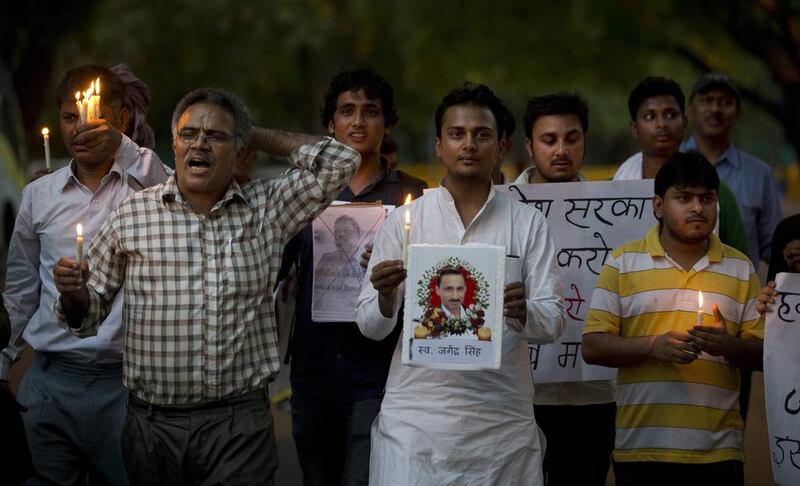NEW DELHI // A video of the final moments of Jagendra Singh, a journalist who was set on fire in Uttar Pradesh, has sent shock waves across India, but no action has been taken against the politician he accused of ordering the attack.
In the months before his death, Singh, a freelancer who wrote for Hindi-language newspapers in his town of Shahjahanpur, had posted a series of allegations on Facebook against Ram Murti Singh Verma, the minister of dairy development in Uttar Pradesh.
Singh’s posts claimed Mr Verma was involved in illegal sand mining and land occupation, and that he took part in a gang rape of a woman from Shahjahanpur.
In a post on May 22, Singh wrote: “Ram Murti Verma might have me killed. At this time, politicians, thugs and the police are all behind me. The burden of writing the truth is weighing on my life.”
On the afternoon of June 1, according to Singh’s statement to the police, cars full of thugs and policemen arrived at his house. After berating him for criticising Mr Verma, they poured kerosene on him and set him on fire.
Singh was taken to hospital, where he died on the evening of June 8. The video, which was shot that day on a mobile phone, was released on Friday.
The clip shows Singh lying in bed with horrific burns, his skin peeling away from his torso and face. A person off camera asks him questions, to which he replies between pain-wracked sobs.
“Why did they have to burn me?” he screams. “If the minister and his men had a problem with me, they could have beaten me up instead of pouring kerosene over me and burning me.”
“Who did this to you?” he is asked.
Singh names a police inspector, Sriprakash Rai, as leading the men that set him on fire. He also accuses Mr Verma of ordering the attack.
The state police said Singh’s burns were from an attempted suicide inside a locked house, and that policemen had barged in after they spotted smoke curling out of a window.
But on Tuesday, the day after Singh’s death, his sons registered a formal police complaint, or FIR, of murder and criminal conspiracy against Mr Verma, Mr Rai and four others.
The murder has provoked fierce criticism of the Uttar Pradesh government and law enforcement machinery.
“The murder of a journalist … is certainly an attack on the freedom of the press, and as such it should be treated seriously,” said C K Prasad, the chairman of the Press Council of India, a statutory body that governs the conduct of India’s print media.
The Committee to Protect Journalists said: “Given the allegations of police participation, and India’s poor track record of solving crimes in connection with reporting on local corruption, the involvement of an independent authority is essential.”
The governor of Uttar Pradesh, appointed by the federal government, called it a “serious issue” on Friday, saying that he had written to the state’s chief minister, Akhilesh Yadav.
Ram Gopal Yadav, a spokesman for the Samajwadi Party, which rules Uttar Pradesh and to which Mr Verma belongs, said the minister would not be removed from his post.
“Merely lodging an FIR does not make anyone a culprit,” Mr Yadav said on Friday. “Action will be taken after the inquiry and culprits will be punished.”
Mr Verma has made no comment on the case.
S R Darapuri, a retired inspector general of police in Uttar Pradesh, told The National that the force had "to a very high extent, become politicised".
The force is subservient to the state government, and is often deployed to carry out the bidding of politicians, he said.
The attack on Mr Singh also shows the deterioration in law and order in Uttar Pradesh, Mr Darapuri said.
The level of crime is reflected in the state legislature, where nearly half of all members – 189 out of 403 – face criminal charges, according to the Association for Democratic Rights, a New Delhi-based non-profit.
There were 33,824 crimes reported in Uttar Pradesh in 2012, the latest year for which the National Crime Records Bureau has data, accounting for roughly a third of all crimes reported in the country.
“There’s a shortage of police, of course, in Uttar Pradesh but also in other states,” Mr Darapuri said. “But the main problem is that the police are not doing what they’re supposed to be doing under the law.”
ssubramanian@thenational.ae





